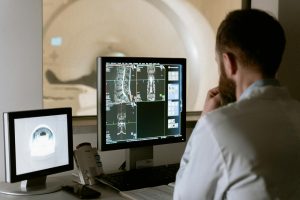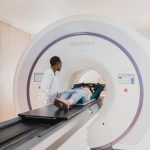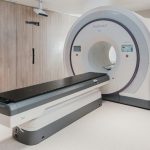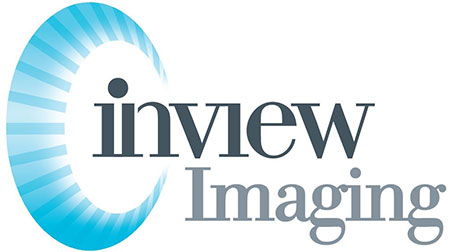InView Imaging: Performing DEXA exams is still a priority
At InView Imaging, we understand that maintaining bone health is crucial, especially as you age. A DEXA scan, or Dual-Energy X-ray Absorptiometry, is a quick, non-invasive procedure that measures bone density. This test is essential for detecting osteoporosis and assessing your risk of fractures, ensuring you can take proactive steps towards maintaining strong, healthy bones.
Choosing InView Imaging for your DEXA scan means entrusting your care to a team with over 50 years of experience serving the San Francisco Bay Area. Our community-based radiology practice is committed to providing personalized and compassionate care tailored to your unique needs.
Our state-of-the-art technology ensures precise and reliable results, helping your healthcare provider develop an effective treatment plan. Our skilled radiologists and staff prioritize your comfort and safety throughout the process, making your experience as stress-free as possible.
We accept most insurance plans, making our services accessible and hassle-free. With convenient locations in Antioch, Oakland, and Fremont, scheduling your DEXA scan at InView Imaging is simple and efficient.
Trust InView Imaging for your bone health needs. Schedule your DEXA scan today and experience the InView difference—exceptional care with a personal touch.

In the realm of medical diagnostics, bone density scans, also known as DEXA scans, play a crucial role in assessing bone health to diagnose osteoporosis and prevent osteoporotic fractures. These scans, interpreted by a radiologist, utilize advanced technology to measure bone mineral density, detect potential issues like osteoporosis, and prevent osteoporotic fractures. By providing detailed insights into bone strength and risk factors for fractures, DEXA scans help healthcare professionals tailor treatment plans effectively. Understanding the significance of these scans is essential for maintaining optimal bone health and preventing debilitating conditions related to skeletal fragility. Stay tuned as we delve deeper into the world of bone density scans, exploring their importance and impact on overall well-being.
Understanding DEXA
Basics Explained
Bone density scan, commonly known as DEXA, is a non-invasive procedure that measures the strength and mineral content of your bones. This test helps in diagnosing osteoporosis and assessing the risk of fractures and bone tissue. Importantly, it detects bone loss early, allowing for timely intervention to prevent fractures.
Individuals over 50 years old, postmenopausal women, those with a family history of osteoporosis, and individuals with certain medical conditions should consider getting a bone density scan from a doctor. Notably, early detection through DEXA scans can help in managing bone health effectively.
How It Works
DEXA scan uses low-dose X-rays to measure bone mineral density. The technology works by emitting two different energy levels of X-ray beams that are absorbed differently by bones and soft tissues. This information is then used to calculate bone density accurately. Moreover, DEXA scans are quick, painless, and emit very low radiation doses compared to traditional X-rays.
During the scan, you lie down on a table while an arm-like device passes over your body to capture images of specific areas such as the spine or hip for bone fracture or broken bone detection. The process takes around 10-30 minutes depending on the number of sites being scanned. Additionally, unlike other imaging techniques like CT scans or MRIs, DEXA focuses solely on assessing bone health without imaging soft tissues.
Measuring Density
The results from a DEXA scan are presented in T-scores and Z-scores. T-scores compare your bone density with that of a healthy young adult while Z-scores compare it with individuals of similar age and size as you. A T-score above -1 indicates normal bone density whereas between -1 and -2.5 signifies osteopenia (low bone mass). Furthermore, various types of measurements include lumbar spine BMD, total hip BMD, femoral neck BMD among others.
Factors influencing bone density results include age, gender, weight, ethnicity, medications like steroids or hormone therapy, lifestyle factors such as smoking or excessive alcohol consumption among others. These factors play a crucial role in determining your risk for osteoporosis and fractures based on the scan results.
Interpreting Results
Interpreting DEXA results requires understanding both T-score and Z-score values along with clinical risk factors unique to each individual’s health profile. Your healthcare provider will assess these scores alongside other risk factors to determine if any preventive measures or treatments are necessary based on your bone health status.
Who Needs DEXA
Risk Factors
Maintaining healthy lifestyle choices such as regular exercise and a balanced diet can significantly improve bone density. Genetic predispositions play a crucial role in determining an individual’s susceptibility to bone density issues. Common risk factors for low bone density include aging, lack of physical activity, smoking, and poor nutrition.
Age Considerations
As individuals age, their bone density naturally declines, making older adults more susceptible to fractures and osteoporosis. Early screening through DEXA scans is essential for older adults to detect potential issues early on. Addressing bone health concerns at different life stages is vital to prevent severe complications later in life.
Understanding Osteoporosis
Osteoporosis is a condition characterized by weak and brittle bones, increasing the risk of fractures. It is primarily caused by low bone density, leading to decreased strength and increased vulnerability. Preventive measures against osteoporosis include adequate calcium intake, vitamin D supplementation, regular weight-bearing exercises, and avoiding smoking and excessive alcohol consumption.
Osteopenia Insight
Osteopenia refers to lower than average bone density but not low enough to be classified as osteoporosis. It serves as a warning sign that an individual may be at risk of developing osteoporosis without intervention. Differentiating between osteopenia and osteoporosis is crucial for implementing appropriate management strategies tailored to each condition.
Frequency of Scans
Initial Test
The first bone density scan is crucial to establish a baseline for future comparisons. It helps in detecting early signs of osteoporosis. During the initial test, you will lie down on a table as the scanner passes over your body, measuring bone density in key areas like the spine and hip. Expect the process to be quick and painless, taking around 10-30 minutes. Wear comfortable clothing without metal zippers or buttons for convenience.
Preparation tips for the first scan include avoiding calcium supplements 24 hours before the test, wearing minimal jewelry, and informing your healthcare provider about any recent medical procedures involving contrast dye.
Follow-Up Scans
Follow-up scans are typically recommended every 1-2 years to monitor changes in bone density accurately. These scans help track how your bones are responding to treatment or lifestyle modifications over time. Based on follow-up results, healthcare providers may adjust treatment plans accordingly to prevent further bone loss or fractures.
Monitoring changes in bone density is essential as it provides valuable insights into the effectiveness of interventions such as medication, exercise routines, and dietary adjustments. Regular follow-up scans allow healthcare professionals to tailor treatments based on individual responses and optimize outcomes.
Adjusting Frequency
Several factors influence the frequency of bone density scans, including age, gender, family history of fractures, prior fracture history, and underlying medical conditions like hyperparathyroidism or rheumatoid arthritis. Guidelines suggest adjusting scan intervals based on risk factors and initial scan results. For example:
High-risk individuals: may require more frequent scans (every 1-2 years)
Low-risk individuals: can opt for less frequent monitoring (every 2-3 years)
Personalized approaches to scan scheduling involve considering an individual’s unique health profile when determining the most suitable frequency for bone density assessments.
By following these guidelines and staying proactive with regular screenings, you can effectively manage your bone health and reduce the risk of fractures.
Benefits of DEXA
Early Detection
Early detection through DEXA scans is crucial for identifying low bone density before it leads to serious issues. These scans play a vital role in catching bone problems early on. Detecting bone issues promptly can prevent fractures and other complications down the line.
The long-term advantages of spotting low bone density early are immense. It allows for timely intervention, reducing the risk of osteoporosis and fractures. DEXA scans enable healthcare providers to develop proactive strategies for maintaining optimal bone health.
Treatment Planning
There are several options available. Medications, dietary changes, exercise routines, and supplements are common approaches. A collaborative approach involving physicians, nutritionists, and physical therapists ensures comprehensive treatment planning tailored to individual needs.
Tailoring treatment plans based on each person’s unique requirements is essential for effective management of low bone density. By considering factors like age, gender, lifestyle, and medical history, healthcare professionals can create personalized strategies that promote optimal bone health.
Monitoring Progress
Regular monitoring of bone density is key to evaluating the effectiveness of treatment plans over time. Follow-up DEXA scans help track progress and make necessary adjustments to the treatment regimen if needed. This ongoing assessment ensures that interventions remain appropriate and beneficial.
Risks and Safety
Radiation Exposure
Bone density scans, like DEXA, involve minimal radiation exposure, equivalent to a few days of natural background radiation.
To minimize concerns regarding radiation exposure during bone density scans, lead aprons are used to shield sensitive body parts.
Strategies such as ensuring proper positioning and using the lowest possible radiation dose help reduce anxiety during the scan.
Minimizing Concerns
Common concerns about bone density scans include fears of claustrophobia or discomfort during the procedure.
To address these concerns, clinics provide clear instructions before the scan and ensure patients feel informed and supported throughout the process.
Measures to enhance patient comfort include offering pillows or blankets for support during the scan and adjusting equipment settings for individual needs.
Limitations
Bone density scans may have limitations in accurately predicting fracture risk due to factors like obesity or joint replacements affecting results.
Factors such as body composition variations can impact scan accuracy; thus, healthcare providers consider these variables when interpreting results.
Complementary tests like CT scans or MRI can complement bone density scans by providing additional information on bone health status.
Comprehensive Safety
Safety protocols during bone density scans involve ensuring equipment calibration for accurate measurements and minimizing errors in results interpretation.
To minimize radiation exposure risks further, technicians use lead shields strategically placed over non-scanned areas of the body.
For vulnerable populations such as pregnant women or children, alternative imaging methods are recommended to avoid unnecessary radiation exposure.
Preparing for DEXA
Before the Scan
Before undergoing a bone density scan, patients should follow specific pre-scan preparations and instructions. It’s essential to inform the healthcare provider about any medications or supplements taken regularly.
Regarding dietary considerations before the scan, individuals should avoid consuming calcium supplements 24 hours prior to the DEXA test. It is advisable not to eat any heavy meals immediately before the procedure.
Patients are advised to wear comfortable attire without metal zippers or buttons. Loose-fitting garments are preferable as they ensure ease of movement during the examination.
During the Scan
During a bone density scan, patients can expect a painless and non-invasive procedure that typically lasts around 10-30 minutes. The machine used emits minimal radiation exposure, making it safe for individuals of all ages.
The process of the bone density scan involves lying down on an examination table while a scanning arm passes over specific areas of your body. Patients need to remain still during this time to ensure accurate results from the test.
Patients play an essential role during the scanning procedure by following instructions from radiology technicians carefully. Cooperation in maintaining stillness and correct positioning is crucial for obtaining precise measurements of bone density levels.
After the Scan
Post-scan guidelines include resuming normal activities immediately after completing the DEXA test without any restrictions. There are no known side effects associated with bone density scans; hence, patients can carry on with their daily routines as usual.
Immediate effects following a bone density scan are minimal since there is no recovery period required post-examination. Patients can leave right after their appointment and resume regular activities without delay.
When waiting for the scan results, individuals may receive them within a few days after undergoing the DEXA test. Healthcare providers will analyze these results and discuss them with patients during follow-up appointments.
Interpreting Results of Bone Density Scan (DEXA)
Understanding Scores
When interpreting bone density scan results, T-scores and Z-scores play a crucial role. T-scores compare your bone density to that of a healthy young adult, indicating the risk of osteoporosis. On the other hand, Z-scores compare your bone density with individuals of your age, gender, and size.
Comparing your scores with reference values is essential for understanding where you stand in terms of bone health. A T-score above -1 is considered normal, between -1 and -2.5 indicates osteopenia (low bone mass), while -2.5 or lower signifies osteoporosis. Similarly, Z-scores below -2 may indicate issues needing further investigation.
The implications of different score ranges are significant for determining the next steps towards improving bone health. Understanding these scores can guide you in making informed decisions about lifestyle changes and treatment options to prevent fractures and maintain strong bones.
Next Steps
After receiving your DEXA scan results, taking actionable steps is crucial for managing your bone health effectively. Consultation with healthcare providers such as doctors or specialists can help you understand the implications of your scores better and create a personalized plan moving forward.
Implementing recommended lifestyle changes based on your results is key to preventing further deterioration of bone density. These changes may include increasing calcium intake through diet or supplements, engaging in weight-bearing exercises like walking or strength training, quitting smoking if applicable, and moderating alcohol consumption.
Enhancing Bone Health
Lifestyle Changes
Making lifestyle modifications is crucial for improving bone health. Consuming a diet rich in calcium and vitamin D can enhance bone density. Engaging in weight-bearing exercises such as walking or dancing strengthens bones.
It’s essential to focus on dietary recommendations that promote healthy bones, including consuming dairy products, leafy greens, and fortified foods. These provide the necessary nutrients for optimal bone health. Incorporating calcium supplements can also aid in maintaining strong bones.
Regular exercise plays a significant role in preserving bone density. Weight-bearing activities like jogging or resistance training help stimulate bone growth and maintain strength. By incorporating these exercises into daily routines, individuals can prevent bone loss effectively.
Medication Options
There are several options available. Bone-strengthening drugs like bisphosphonates help increase bone mass and reduce the risk of fractures. However, they may have side effects such as gastrointestinal irritation.
It’s important to consider the benefits of these medications against their potential side effects when prescribed by healthcare providers. Other medication options include hormone-related therapies that can improve low bone mass conditions effectively but require careful monitoring due to associated risks.
Regular Exercise of Bone Density Scan (DEXA)
Exercise is vital for maintaining optimal bone density levels throughout life. Weight-bearing exercises such as running or jumping rope help build and strengthen bones by putting stress on them. Resistance training with weights also contributes significantly to enhancing bone strength.
Incorporating a variety of exercises into one’s routine is key to promoting overall bone health. Activities like yoga or Pilates improve balance and flexibility while still benefiting bones’ mineral content through weight-bearing poses and movements.
Future of Bone Density Scan (DEXA)
Technological Advances
Recent advancements in bone density scan technology have revolutionized the field of bone health diagnostics. These technological improvements have significantly enhanced the precision and efficiency of bone scans. The introduction of dual-energy X-ray absorptiometry (DEXA) scans has become the gold standard for assessing bone mineral density.
The impact of these technological innovations on bone density scan accuracy is profound. DEXA scans, utilizing low-dose X-rays, provide detailed images that enable healthcare professionals to evaluate bone strength and detect potential issues such as osteoporosis. The high level of precision offered by DEXA scans allows for early detection and intervention, crucial in preventing fractures and other complications related to decreased bone density.

Future trends in bone health diagnostics indicate a shift towards more personalized and predictive approaches. Emerging technologies like quantitative computed tomography (QCT) offer three-dimensional assessments of bone quality, providing a comprehensive evaluation beyond traditional two-dimensional scans. These advancements pave the way for tailored treatment plans based on individual risk factors and characteristics.
Alternative Methods Bone Density Scan (DEXA)
In addition to traditional bone density scanning, non-traditional approaches are gaining recognition for their role in improving bone health. Physical activities such as weight-bearing exercises and resistance training are known to enhance bone density naturally without relying solely on medical interventions. These activities stimulate bone growth, promoting overall skeletal strength.
Complementary therapies such as nutrition counseling and supplementation play a significant role in maintaining optimal bone density levels. Adequate intake of calcium, vitamin D, magnesium, and other essential nutrients supports healthy bones and reduces the risk of fractures. Integrating these dietary components with regular exercise contributes to long-term skeletal health benefits.
Exploring integrative methods that combine conventional medical treatments with holistic practices shows promise in enhancing overall bone health outcomes. Practices like acupuncture, yoga, and mindfulness techniques may complement standard treatments by addressing underlying stressors or imbalances that impact bone density regulation.
Summary
In summary, bone density scans (DEXA) play a crucial role in assessing your bone health and detecting potential issues early on. Knowing who needs these scans, how often to get them, and understanding the benefits and risks can empower you to take charge of your bone health. Preparing for the scan and interpreting the results accurately are essential steps in this process. Enhancing your bone health through lifestyle changes and staying informed about advancements in bone scan technology can further aid in maintaining strong bones for the future.

Take action now by scheduling a consultation with your healthcare provider to discuss the possibility of getting a DEXA scan. Stay proactive about your bone health to ensure a strong foundation for a healthy and active life. Remember, knowledge is power when it comes to caring for your bones!
Frequently Asked Questions About Bone Density Scan (DEXA)
What is a bone density scan (DEXA)?
A bone density scan, also known as DEXA or DXA, is a non-invasive test that measures the strength and mineral content of your bones to assess the risk of fractures and diagnose conditions like osteoporosis.
Who should consider getting a Bone Density Scan (DEXA)?
Individuals at higher risk for osteoporosis, such as postmenopausal women, men over 50 with risk factors, those with a history of fractures, or on specific medications that affect bone health should consider getting a DEXA scan.
How often should one undergo Bone Density Scan (DEXA)?
The frequency of DEXA scans varies based on individual risk factors. Generally, it’s recommended every 1-2 years for those with low bone density or other risks. Consult your healthcare provider to determine the appropriate scan schedule for you.
What are the benefits of having a Bone Density Scan (DEXA)?
DEXA scans help in early detection of osteoporosis, assessing fracture risk, monitoring treatment effectiveness, and guiding preventive measures to improve bone health. It provides valuable information to develop personalized strategies for maintaining strong bones.
Is there any preparation required before a Bone Density Scan (DEXA)?
Typically, there is no special preparation needed for a DEXA scan. You may be advised to avoid calcium supplements before the test. Wear comfortable clothing without metal accessories and inform the technologist if you might be pregnant.
How are results from a bone density scan interpreted Bone Density Scan (DEXA)?
Results from a DEXA scan are presented as T-scores comparing your bone density to that of an average young adult. A score above -1 is considered normal; between -1 and -2.5 indicates low bone mass (osteopenia); below -2.5 suggests osteoporosis requiring intervention.


